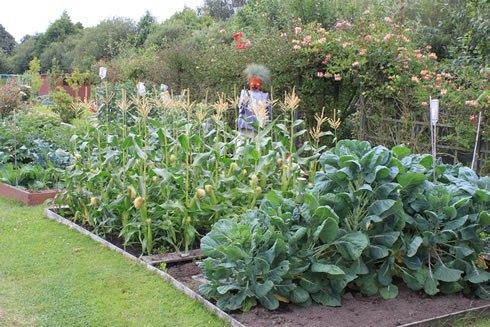Almost everything you have sown, planted and nurtured through the spring and early summer will be coming to fruition now. Daily trips to your plot should see you returning home with everything from peas, beans, carrots, beetroot, sweetcorn, tomatoes, peppers, potatoes, onions and salads to berries, currants and other fruits.
Weed and water – in a dry summer the weed growth should slow down but it is important to continue regular watering to promote healthy growth and prevent plants bolting prematurely.
Harvest regularly – courgettes, runner beans and French beans are notorious for the speed at which they grow, check daily and pick before they grow too large or become stringy.
Ask neighbouring plot-holders to water courgettes and tomatoes if you are going away.
Tie up tomatoes, peppers and cucumbers – as the fruits develop they become heavy and the plants will require extra support to the main stems to avoid breakages and loss of crops
Earth up – potatoes, trench celery to keep the stems out of the light and earth up around brassicas to support unsteady stems.
Propagate strawberries – any strawberry runners can be pegged down to root, and then potted up ready to transplant.
There is very little to sow or plant now in time for harvesting this year although you could try Lettuce – still possible to sow lettuce though they may not germinate if the weather is too hot. For late autumn and winter salads continue to succession sow rocket, land cress and winter purslane,
short carrots, radish, spinach, spring onions, chard, courgettes, runner beans, rocket, pak choi.
However as space becomes vacant from crops harvested you can begin to plant out overwintering crops, such as
Cauliflowers – August is the time to transplant winter and spring cauliflowers. If they overwinter successfully they should give you a harvest in the New Year, January onwards.
Cabbages, Broccoli & Kale – sow a few more cabbages now for harvesting next spring, in a temporary seed bed or pots until space is available on the main plot. Cover them with nets or fleece to keep birds off.
Tomatoes – take side shoots off tomatoes and remove yellow leaves. Pinch tops out when they reach the top of greenhouse or stake.
Onions – ripen by bending leaves just above neck of each plant.
Leeks – blanch by earthing up around stems, be aware that early maturing leeks may not last over winter.
Broad beans – If you cut them to 3 shoots they will grow again and you will have a few extra beans.
Runner beans – pinch out tops when they reach the top of the cane.
Cabbages – feed winter cabbages with a nitrogen feed.
Cauliflowers – harvest and wrap in cling film, they will last longer in fridge.
Courgettes – pick by twisting them off. Make sure you pick them regularly or they will stop fruiting (and get too big).
Potatoes – If you want to store for a bit longer, cut the tops off and leave in ground for 10 days, then lift.
Pick – cucumbers by cutting with a sharp knife – if you only need a half then cut a half – it will keep growing on the plant! Pick runner beans young, they taste better and are less stringy, pick French beans when they snap easily.
Weed around plants.
If you have any empty ground try sowing some green manure, it will improve the fertility of your soil.
Stake brussel sprouts and purple sprouting.
Prune stone fruits such as plums, peaches, etc. If you prune these in winter they will get silver leaf which can kill the tree.
Summer prune apples and pears.
Damp down greenhouse to avoid red spider mite.
Check brassicas regularly for any signs of cabbage white butterfly caterpillars, or whitefly.
Check for maggots in plum and apple trees, if you have them next year put up pheromone traps.
Look out for blight on potatoes.
Cut Jerusalem artichoke stems to a foot from the ground
Sow maincrop turnips
Start sowing successional rows of winter spinach
Sow red cabbage in a sheltered spot for planting out in spring
Hoe, hoe, hoe

